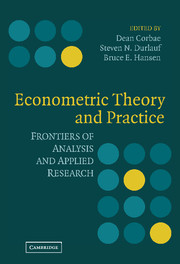Book contents
- Frontmatter
- Contents
- Preface: In Praise of a Remarkable Teacher
- Contributors
- Introduction
- PART I HIGHER-ORDER ASYMPTOTICS
- 1 Edgeworth Expansions for the Wald and GMM Statistics for Nonlinear Restrictions
- 2 Moment Selection and Bias Reduction for GMM in Conditionally Heteroskedastic Models
- PART II IV SPECIFICATION TESTS
- PART III NONSTATIONARITY
- PART IV LAD AND QUANTILE REGRESSION
- PART V NONSTATIONARY PANELS
- Index
1 - Edgeworth Expansions for the Wald and GMM Statistics for Nonlinear Restrictions
Published online by Cambridge University Press: 05 June 2012
- Frontmatter
- Contents
- Preface: In Praise of a Remarkable Teacher
- Contributors
- Introduction
- PART I HIGHER-ORDER ASYMPTOTICS
- 1 Edgeworth Expansions for the Wald and GMM Statistics for Nonlinear Restrictions
- 2 Moment Selection and Bias Reduction for GMM in Conditionally Heteroskedastic Models
- PART II IV SPECIFICATION TESTS
- PART III NONSTATIONARITY
- PART IV LAD AND QUANTILE REGRESSION
- PART V NONSTATIONARY PANELS
- Index
Summary
INTRODUCTION
The Wald test is a popular test of statistical hypotheses largely because it is simple to compute. There are many reasons, however, to believe that the Wald test is generically a poor choice as a test of nonlinear hypothesis. One reason frequently mentioned is that the Wald statistic is not invariant to the algebraic formulation of the hypothesis. Gregory and Veall (1985) and Lafontaine and White (1986) showed in Monte Carlo simulations the potentially large consequences of alternative algebraic formulations. Park and Phillips (1988) formalized this finding by showing that the coefficients of the Edgeworth expansion of the Wald statistic depend on the formulation.
Separately, Newey and West (1987) proposed a distance generalized method of moments (GMM) statistic for nonlinear hypotheses. In the context of linear regression, their statistic is simply the GMM criterion function evaluated at the restricted estimates. When the hypothesis is a linear restriction on the parameters, their test corresponds to the Wald statistic. When the hypothesis is nonlinear, the two statistics differ. A striking feature of the GMM distance statistic is that it is invariant to the algebraic formulation of the hypothesis. (The invariance follows directly from its definition in terms of the criterion function.) The GMM distance statistic also has the advantage of being robust to heteroskedasticity (if a heteroskedasticity-consistent covariance matrix is used to define the GMM criterion). This is in contrast to the likelihood ratio statistic, which is invariant to formulation of the hypothesis but is not robust to heteroskedasticity.
- Type
- Chapter
- Information
- Econometric Theory and PracticeFrontiers of Analysis and Applied Research, pp. 9 - 35Publisher: Cambridge University PressPrint publication year: 2006
- 6
- Cited by



